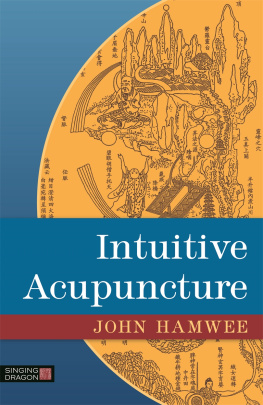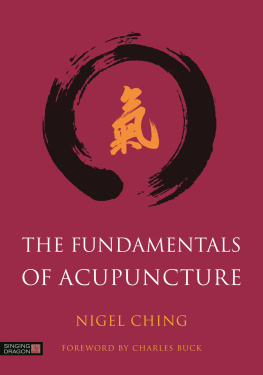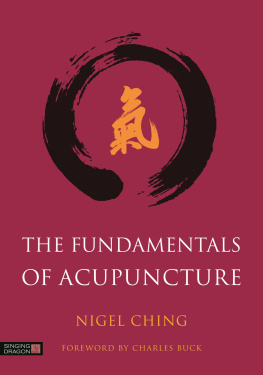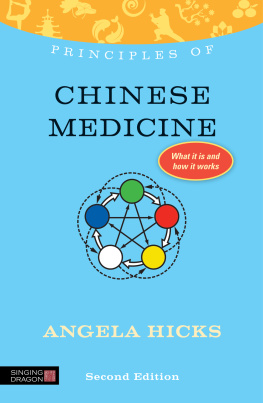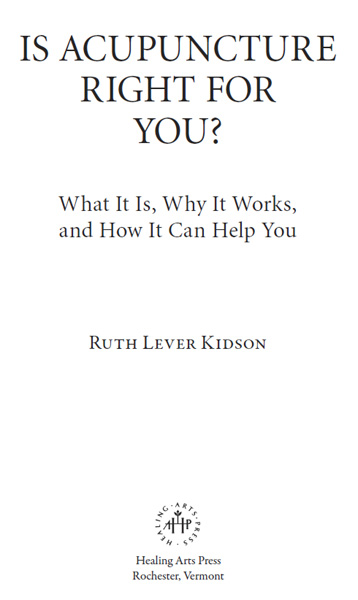
This book is dedicated to the memory of: Marie Ross and Tom Dummer, who first led me into the world of complementary medicine; my aunt, Fredi Morgan; three dear friends, Rosa Taylor, Margery Lamont, and Hereward Overnell; and my father, Lionel Lever.
A NOTE ON THE LANGUAGE
Throughout this book doctors, acupuncturists, and patients tend to be referred to as he. This does not, of course, imply that there are no women doctors, acupuncturists, or patients, but is to prevent the reader from becoming irritated by a constant repetition of he or she and to prevent the author from becoming irritated at having to use the ungrammatical they.
Contents
Introduction
A lthough it is only in fairly recent times that acupuncture has becomea recognized therapy in the West, its popularity as an alternative toWestern medicine is increasing, particularly for the treatment of chronicallypainful conditions. And although of course no therapyWesternor complementaryworks for everyone, many patients are finding thatacupuncture offers effective relief not just for pain but also for a widerange of medical problems.
Among those patients who have experienced acupuncture and whosehealth has improved, however, there must be some who have wonderedjust how much of the improvement was due to the treatment and howmuch was fortuitous. Did it just happen that their illness took a turn forthe better at the same time that they started going to the acupuncturist?Or could it have been a case of mind over matter? Even to those who haveexperienced acupunctureand very much more to those who haventitcan seem a rather bizarre form of treatment. In the tradition of Westernmedicine we are accustomed to having treatment directed at the part of thebody that is malfunctioning. If we sprain an ankle, we have it wrapped; ifwe develop a boil, we have it lanced; if an appendix becomes inflamed, wehave it removed. But acupuncture treats all ailments by sticking needlesinto the skin, and very often the needles are put into areas of the body thatseem to be totally unrelated to the illness from which we are suffering.
There was a time when people unquestioningly accepted whatevertreatment their doctors dished out, but, thankfully, times have changed.Patients nowadays are much better informed and, as a result, are able toplay a much more active role in their own recovery from illness. So it isnatural that anyone thinking of going to an acupuncturist wants to understandsomething of the therapy. Cartoons about acupuncture seem alwaysto show someone stuck full of needles looking something like CustersLast Stand; this perception, together with a lack of accurate knowledgeabout the therapy, can make the prospect of going for treatment quitefrightening. Even in Western medicine a patient will tolerate treatmentand investigations far more readily if he is told in advance what is goingto be done and why. But nobody likes to appear foolish. It takes a bravepatient, already somewhat intimidated by the fact of having things doneto him, to speak up and ask, Why are you doing that? And what do youintend to do next? The purpose of this book, then, is to explain what theacupuncturist is doing and why.
In order to understand the theory of acupuncture, we have to forgetall the concepts of Western medicine that we have been brought up with.Not only is acupuncture theory couched in terms evolved in an alien(Chinese) culture, but it is also far more esoteric than the flesh-and-bonestheories of Western medicine. The latter treats the physical matter of thebody. If bodily function has become disrupted, Western medicine treatsit with drugsfor example, by giving antihypertensives to treat highblood pressure. If a body part has become irreparably diseased or is doingthe patient harm, it is surgically removedfor instance, the removal ofan inflamed appendix or an overactive thyroid gland. Or if the part hasmerely become distorted, it may be surgically repaired, as in the case of aprolapsed uterus. For parts of the body whose function is inadequate orinappropriate, there is a variety of therapies whose aim is to encourage thereturn to normal function, such as physiotherapy for poorly functioningmuscles and psychotherapy for mental problems.
Acupuncture, however, uses a single therapythe insertion ofneedles into the skinto treat a variety of ailments that might be treated by Western doctors with drugs, surgery, or a range of other therapies.Acupuncture can treat all ailments in the same way because it sees themas stemming from the same causea disruption of the energy flow orvital force of the body. This vital force (of which much more will be saidin chapter 2) does not play a role in Western medicine. But in Chinesemedicine it is seen as fundamental to normal bodily function; its disruptioncan result in malfunction and disease. The vital force is said to flowthrough a system of channels, or meridians, and disruption of that flowwill manifest itself as disease in those parts of the body supplied by theaffected meridian. The aim of acupuncture, which consists of insertingneedles at various well-defined points lying along the meridians, is torestore balance to the energy flow and thus return the associated partto its normal function.
The word acupuncture is derived from the Latin acu (meaning witha needle) and the English puncture, but in fact piercing the skin is notessential to the treatment. There are several ways in which the flow of energythrough the meridians can be manipulated. Indeed, some practitionersprefer to describe the treatment they offer as meridian therapy ratherthan acupuncture. As an alternative to needles, pressure may be used in aform of massage, or the points may be warmed (or even burned, as I shallmention in chapter 1). Lasers have also been used to stimulate the points.It is nowadays even possible to buy a do-it-yourself acupuncture kit completewith an electrical stimulator with which to treat your own points.However, the latter is not recommended; without thorough training inthe theory and practice of acupuncture, it is rather like buying a knife andan anatomy book and trying to take out your own appendix.
This is not, therefore, a teach-yourself-acupuncture book. What I willtry to do is to demonstrate how an acupuncturist makes his diagnosis andhow, in the light of this diagnosis, he treats his patient. The aim is twofold:to make going to the acupuncturist for the first time less intimidating,and to throw light on some of the mysteries that the therapist may nothave time to explain during treatment (such as why, if you go complainingof a headache, he may stick a needle in your foot!).
Acupuncture originated, of course, in a culture quite different from our own and was exported to the West comparatively late in its evolution. Its history, therefore, is a fundamental part of what it is today, and to its history the next chapter is devoted.
A Short History of Acupuncture
A cupuncture is based on a completely different set of theories fromthose of Western medicine. In the West a doctor will base his diagnosisof a patients illness on his knowledge of anatomy, physiology, biochemistry,and pathology; then, having put a name to the disease, he will decidewhether to treat the patient with drugs, surgery, or other techniques.However, there are some patients whom doctors find it very difficult totreat because, although they are clearly unwell, all the tests are normal anda diagnosis cannot be made. For these patients acupuncture (like manyother complementary therapies) is perfectly suitable: It does not require adiagnosis in Western terms for the patient to be treated successfully.
Acupuncture is one of the oldest therapies known to humanity, havingbeen in use for well over two thousand years. And although developmentshave occurred, from time to time, its basic theory and practice are still muchthe same as when it was practiced twenty centuries ago. This theory alsoforms the foundation of Chinese herbal medicine, with which acupunctureis frequently used in the East. When acupuncture first became popular inthe West it was usually used alone, but many practitioners now train inherbal medicine as well so that they can offer both therapies.
Next page

